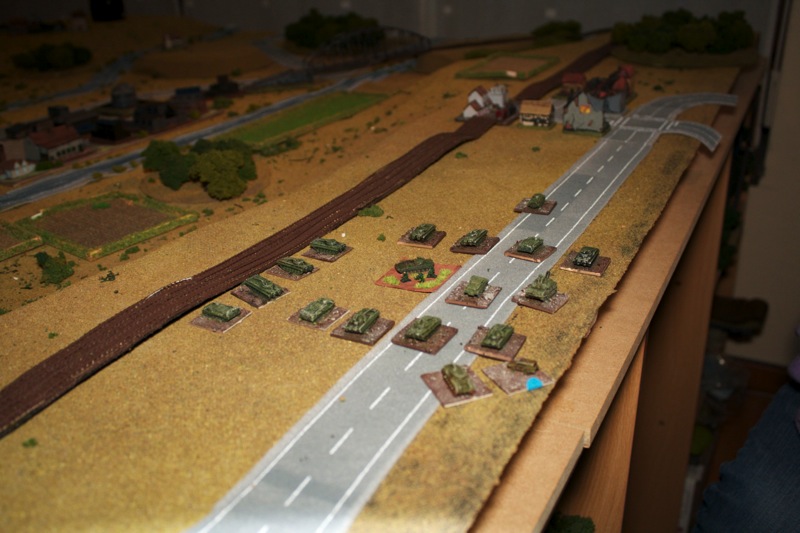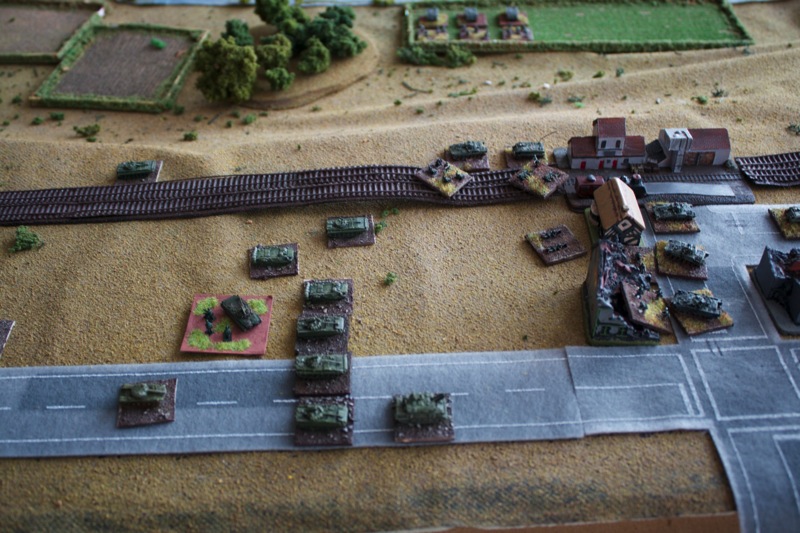Over the last two gaming evenings at the Command Post, Eddy, Koen and myself played the big Cold War Commander game
mentioned before - the Battle of Semmel Valley. This is a fictional scenario in an equally fictional Cold War gone hot setting, where a reinforced Russian Motor Rifle Regiment has to break through the defences of a British battle group, somewhere in Germany east of the Rhine.
The battlefield was, as the name already hints at, the valley of the River Semmel, which splits into the Kleine and Grosse Semmel in the middle of the battlefield. This is an overview shot of the table, with the BUA's named for reference. The British can deploy hidden anywhere on the table, the Russians enter from the left of the picture:

The Russian mission was to control the exits of the valley - the two road exits between the river forks on the right of the table. As the Semmel itself was unfordable (and we conveniently ignored the fact that all of the AFV's in the game were actually amphibious), that meant that the Russians would have to take the bridge in the centre of the table, or build a bridge somewhere else using their bridging column (the presence of which was unknown to the British players).
The Russian plan recognised that a straight attack through the valley would not be a good idea. Instead, the northern flank of the battlefield, with the village of Hochdorf, would see the major outflanking attack, with only a screening or pinning attack envisioned in the valley itself. One rifle battalion would attach Hochdorf itself while the two tank battalions would follow this attack but swerve left to take any British forces in the valley itself under fire from the high ground. When British resistance was neutralised, the bridging column would drive up and bridge the Semmel river to allow the tanks to cross.
In the valley itself, a rifle battalion would advance and take Klein Semmelhausen and stop there, with the intent of pinning any enemy forces in Gross Semmelhausen to support the main attack. The third rifle battalion was held in reserve to drive up the main road to the bridge once it was clear.
As opposed to the well established maxim, the battle went pretty much according to plan for the Russians. The rifle battalion attacking Hochdorf was almost completely wiped out and never got into the village itself (it was defended by two British infantry companies) but did pin the British in Hochdorf enabling the T72 and T80 battalions to take up positions behind them and engage the British in the valley. The attack on Klein Semmelhausen established that there were no British troops in either Klein or Gross Semmelhausen, but did draw an attack of Chieftain tanks on them, part of which were subsequently engaged and destroyed by the Russian tanks.
Some pictures of the battle in progress:

Russian rifle battalion driving on Hochdorf. By the end of the game, only a reinforced company would be left of them, not much further up the road from where they were in this photo.

Russian advance triggers a British ambush along the right hand road. This and a second ambush along the left hand road accounted for some delays in the Russian advance and some wrecked BMP vehicles.

A long column of T72 tanks advances up the right flank.

The Russian tank positions overlooking the valley. T80s in background on the hill, T72 in foreground.

The aftermath of the battle of Hochdorf. A severely depleted Russian Rifle battalion not getting any closer to the village itself.

The positions at the end of the game.
Based on the positions as shown in that last picture, we more or less decided that the battle was going to be a Russian victory. The tank battalions had established fire superiority over the central bridge area, the bridging column was moving up to enable the Russian tanks to cross the river, and the final Russian rifle battalion was ready for its dash up the central road and on across the bridge.
Despite some good experiences with the
Xkrieg Commander series of rules in the past, we felt that for this particular game it did not work. Getting to the limited result mentioned above took us two gaming evenings, which is a bit too slow for our liking.
Phil's post has more details on this.









